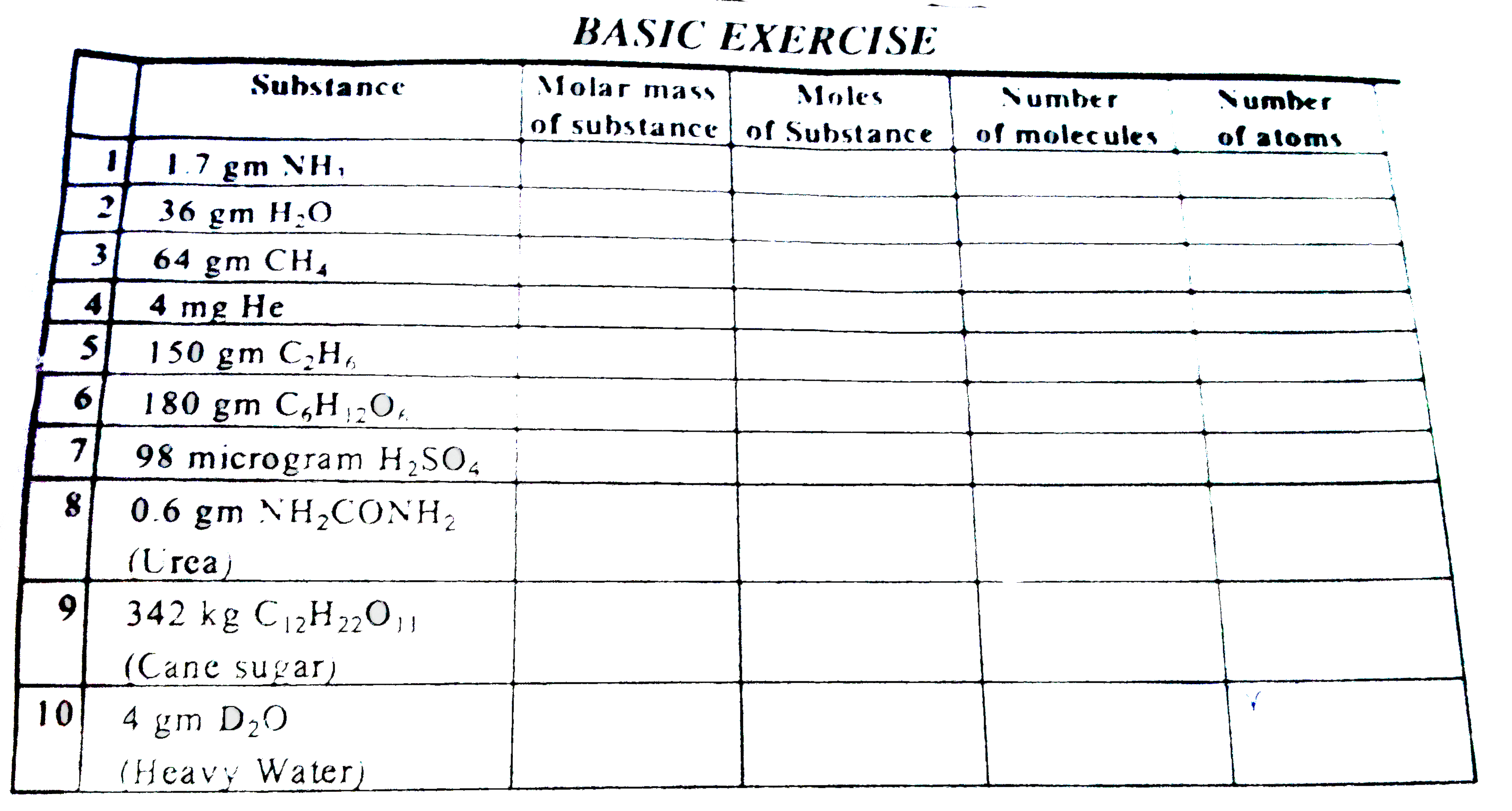N2+3H2⇔2NH3
1mole N2 and 3 moles H2 are present at start in 1 L flask. At equilibrium NH3 formed required 100 mL of 5 M HC1 for neutralisation hence Kc is
(0.5)2(0.75)(2.25)3
(0.5)2(0.5)(2.5)3
(0.5)L(0.75)(2.5)3
none of these
The correct Answer is:A
To solve the problem, we will follow these steps:
Step 1: Write the balanced chemical equation.
The balanced equation for the reaction is:
N2+3H2⇌2NH3
Step 2: Determine initial moles of reactants.
Initially, we have:
- 1 mole of N2
- 3 moles of H2
Step 3: Define the change in moles at equilibrium.
Let α be the number of moles of N2 that reacts at equilibrium. Then:
- Moles of N2 at equilibrium = 1−α
- Moles of H2 at equilibrium = 3−3α
- Moles of NH3 formed = 2α
Step 4: Use the information about neutralization to find α.
We know that the amount of NH3 formed can neutralize 100 mL of 5 M HCl.
First, calculate the moles of HCl:
Moles of HCl=Molarity×Volume=5mol/L×0.1L=0.5moles
Since NH3 reacts with HCl in a 1:1 ratio, the moles of NH3 formed is also 0.5 moles:
2α=0.5⟹α=0.25
Step 5: Calculate moles of reactants at equilibrium.
Now we can substitute α back into our expressions for the moles of reactants:
- Moles of N2 at equilibrium = 1−0.25=0.75
- Moles of H2 at equilibrium = 3−3(0.25)=2.25
- Moles of NH3 at equilibrium = 0.5
Step 6: Calculate the equilibrium concentrations.
Since the volume of the flask is 1 L, the concentrations are equal to the number of moles:
- (N2)=0.75M
- (H2)=2.25M
- (NH3)=0.5M
Step 7: Write the expression for Kc.
The equilibrium constant Kc for the reaction is given by:
Kc=(NH3)2(N2)(H2)3
Step 8: Substitute the equilibrium concentrations into the Kc expression.
Kc=(0.5)2(0.75)(2.25)3
Step 9: Calculate Kc.
Calculating the denominator:
(2.25)3=11.390625
Now substituting:
Kc=0.250.75×11.390625=0.258.54296875≈0.0293
Final Answer:
Thus, the equilibrium constant Kc is approximately 0.0293.
---
The balanced equation for the reaction is:
N2+3H2⇌2NH3
Initially, we have:
- 1 mole of N2
- 3 moles of H2
Let α be the number of moles of N2 that reacts at equilibrium. Then:
- Moles of N2 at equilibrium = 1−α
- Moles of H2 at equilibrium = 3−3α
- Moles of NH3 formed = 2α
We know that the amount of NH3 formed can neutralize 100 mL of 5 M HCl.
Moles of HCl=Molarity×Volume=5mol/L×0.1L=0.5moles
2α=0.5⟹α=0.25
Now we can substitute α back into our expressions for the moles of reactants:
- Moles of N2 at equilibrium = 1−0.25=0.75
- Moles of H2 at equilibrium = 3−3(0.25)=2.25
- Moles of NH3 at equilibrium = 0.5
Since the volume of the flask is 1 L, the concentrations are equal to the number of moles:
- (N2)=0.75M
- (H2)=2.25M
- (NH3)=0.5M
The equilibrium constant Kc for the reaction is given by:
Kc=(NH3)2(N2)(H2)3
Kc=(0.5)2(0.75)(2.25)3
Calculating the denominator:
(2.25)3=11.390625
Now substituting:
Kc=0.250.75×11.390625=0.258.54296875≈0.0293
Thus, the equilibrium constant Kc is approximately 0.0293.
Topper's Solved these Questions
- CHEMICAL EQUILIBRIUMBOOK - A2ZCHAPTER - CHEMICAL EQUILIBRIUMEXERCISE - Section B - Assertion Reasoning
18 Videos
- CHEMICAL EQUILIBRIUMBOOK - A2ZCHAPTER - CHEMICAL EQUILIBRIUMEXERCISE - NEET/AIPMT Questions
20 Videos
- CHEMICAL EQUILIBRIUMBOOK - A2ZCHAPTER - CHEMICAL EQUILIBRIUMEXERCISE - Le - Chatellers'S Principle
93 Videos
- CHEMICAL BONDING AND MOLECULAR STRUCTUREBOOK - A2ZCHAPTER - CHEMICAL BONDING AND MOLECULAR STRUCTUREEXERCISE - Section D - Chapter End Test
30 Videos
- CHEMICAL THERMODYNAMICSBOOK - A2ZCHAPTER - CHEMICAL THERMODYNAMICSEXERCISE - Section D - Chapter End Test
30 Videos
Similar Questions
Knowledge Check
In a one litre containder 1 mole of N2 and 3 moles of H2 were introduced. After some time at equilibrium, ammonia formed requires 100 ml of 1 M H2SO4 for complete neutralisation. Then Kc for reaction will be
A12.25×10−4B2.26×10−3C2.26×10−6D2.26×10−4For N2+3H2⇔2NH3, 1 mole N2 and 3 mol H2 are at 4 atm. Equilibrium pressure is found to be 3 atm. Hence, Kp is
A1(0.5)(0.15)3B1(0.5)(0.15)3C3×3(0.5)(0.15)3DNone of these1 mole of N2 and 2 moles of H2 are allowed to react in a 1dm3 vessel. At equilibrium, 0.8 mole of NH3 is formed. The concentration of H2 in the vessel is
A0.6 moleB0.8 moleC0.2 moleD0.4 mole
Consider the following reaction equilibrium
N2(g)+3H2(g)⇔2NH3(g)
Initially, 1 mole of N2 and 3 moles of H2 are taken in a 2 flask. At equilibrium state if, the number of moles of N2 is 0.6, what is the total number of moles of all gases present in the flask ?
View SolutionFor the reaction, N2+3H2⇔2NH3, in a vessel equal moles of N2 and H2 are mixed to attain equilibrium. At equilibrium:
View SolutionN2+3H2→2NH3. 1 mol N2 and 4 mol H2 are taken in 15L flask at 27∘C After cmomplete conversion of N2 into NH3,5L of H2O is added pressure set up in the flask is:
View SolutionN2+3H2⇔2NH3. This is gaseous phase reaction taking place in 1L flask at 127∘C. Starting with 1 mole N2 and 3 moles H2, equilibrium required 500mL of 1M HCl. Hence Kc is approximately
View SolutionN2(g)+3H2(g)⇔2NH3(g).This is a gaseous phase reaction taking place in 1 L flask at 127∘C.Starting with 1 mole of N2 and 3 mole of H2, the equilibrium mixture obtanied is such that if it is titrated requires 500 mL of 1.0 M H2SO4 for neutralisation. Which of the following is the most appropritate KC?
View Solution
